Meditation has been practiced for centuries, as a way to calm the soul and bring about inner peace. According to a new study in Psychological Science, a journal of the Association for Psychological Science, there is now evidence that a specific method of meditation may temporarily boost our visuospatial abilities (for example, the ability to retain an image in visual memory for a long time). That is, the meditation allows practitioners to access a heightened state of visual-spatial awareness that lasts for a limited period of time.
Normally when we see something, it is kept in our visual short-term memory for only a brief amount of time (images will begin to fade in a matter of seconds). However, there have been reports of Buddhist monks who have exceptional imagery skills and are able to maintain complex images in their visual short-term memory for minutes, and sometimes even hours. Led by psychologist Maria Kozhevnikov of George Mason University, a team of researchers investigated the effects of different styles of Buddhist meditation on visuospatial skills.
The researchers focused on two styles of meditation: Deity Yoga (DY) and Open Presence (OP). During DY meditation, the practitioner focuses intently on an image of deity and his or her entourage. This requires coming up with an immensely detailed, three-dimensional image of the deity, and also focusing on the deity's emotions and environment. In contrast, practitioners of OP meditation believe that pure awareness cannot be achieved by focusing on a specific image and therefore, they attempt to evenly distribute their attention while meditating, without dwelling on or analyzing any experiences, images, or thoughts that may arise.
In these experiments, experienced DY or OP meditation practitioners along with nonmeditators participated in two types of visuospatial tasks, testing mental rotation abilities (e.g., being able to mentally rotate a 3-D structure) and visual memory (e.g., being shown an image, retaining it in memory and then having to identify it among a number of other, related images). All of the participants completed the tasks, meditators meditated for 20 minutes, while others rested or performed non-meditative activities, and then completed a second round of the tasks.
The results revealed that all of the participants performed similarly on the initial set of tests, suggesting that meditation does not result in an overall, long-lasting improvement of visuospatial abilities. However, following the meditation period, practitioners of the DY style of meditation showed a dramatic improvement on both the mental rotation task and the visual memory task compared to OP practitioners and controls. These results indicate that DY meditation allows practitioners to access greater levels of visuospatial memory resources, compared to when they are not meditating. The authors state that this finding "has many implications for therapy, treatment of memory loss, and mental training." Although, they conclude, future studies will need to examine if these results are specific to DY meditation, or if these effects can also occur using other visual meditation techniques.
Subscribe to:
Post Comments (Atom)



No comments:
Post a Comment